Marinated vegetable salad is more than just a colorful side dish—it’s a versatile, make-ahead delight that brings fresh flavor, texture, and nutrition to your table. Whether you’re prepping for a summer BBQ, looking for healthy meal prep ideas, or just craving something tangy and crunchy, this salad fits the bill. Packed with vibrant, crisp vegetables soaked in a flavorful vinaigrette, it delivers a perfect balance of sweet, savory, and tart notes that dance across your taste buds.
In this guide, you’ll learn everything you need to know about making marinated vegetable salad from scratch—from picking the best veggies to mastering the marinade, proper storage, regional variations, and more. We’ll also answer some of the most common questions like “What are the best vegetables to marinate?” and “How long does it last in the fridge?”
Table of Contents
Let’s get started with why this salad deserves a spot on your weekly menu.
Why Marinated Vegetable Salad Is a Must-Try
What Makes Marinated Vegetable Salad Unique?
Unlike traditional leafy salads that wilt after a few hours, marinated vegetable salad holds its crispness and flavor for days. The key is in the marinade—a zesty blend of vinegar, oil, and herbs that soaks into the veggies, enhancing their flavor over time. This makes it ideal for meal prepping or planning dishes in advance for gatherings.
Marinated salads also stand out because they:
- Have a bold, tangy flavor profile
- Stay fresh in the fridge for up to a week
- Require no reheating or complex prep
- Are perfect for any season or occasion
What really sets them apart is how the flavors deepen over time. By the next day, every bite is more flavorful than the last.
Health Benefits of Marinated Vegetables
If you’re trying to eat healthier without sacrificing flavor, marinated vegetable salad is a no-brainer. Here’s why it’s a top pick:
- High in fiber and antioxidants: Veggies like broccoli, carrots, and cauliflower are packed with nutrients that support digestive health and immunity.
- Low in calories: The dish is naturally low in fat and calories, especially if you go light on the oil.
- Heart-friendly: Vinegar-based dressings have been linked to better blood sugar control and heart health.
- Supports hydration: With water-rich veggies like cucumbers and bell peppers, this salad helps you stay refreshed.
And since the veggies are raw or lightly blanched, they retain their nutrients better than cooked alternatives. So, not only are you enjoying a delicious dish—you’re nourishing your body in the best way.
Choosing the Best Vegetables for Marination
Top Vegetables That Soak Up Marinade Best
The foundation of a great marinated vegetable salad lies in the veggies you choose. Some vegetables naturally absorb marinade better than others, giving you bolder flavor and better texture. Here are the top picks that not only hold up well but also soak in flavor beautifully:
| Vegetable | Why It Works Well |
|---|---|
| Cauliflower | Crunchy texture, absorbs tangy flavors |
| Broccoli | Holds marinade in its florets |
| Carrots | Natural sweetness pairs with vinegar |
| Cucumbers | Adds freshness, absorbs fast |
| Bell Peppers | Sweet, crisp, and colorful |
| Cherry Tomatoes | Juicy, balances acidity with sweetness |
| Red Onions | Mild spice becomes mellow when marinated |
| Celery | Extra crunch, neutral flavor |
Avoid watery vegetables like iceberg lettuce or soft ones like avocado—they don’t hold up in the marinade and can get mushy.
Marinating works best when you cut veggies into bite-size, uniform pieces. This helps them absorb more of the vinaigrette and makes each bite more consistent.
Seasonal Picks for Maximum Freshness
One of the beauties of this salad is how easily you can adapt it to the season. Using in-season vegetables not only improves flavor but also reduces cost and increases nutritional value. Here’s a seasonal guide:
| Season | Best Veggies to Use |
|---|---|
| Spring | Asparagus, radishes, baby carrots, snap peas |
| Summer | Zucchini, cucumbers, cherry tomatoes, corn |
| Fall | Cauliflower, sweet peppers, broccoli, carrots |
| Winter | Beets (roasted first), winter radishes, cabbage |
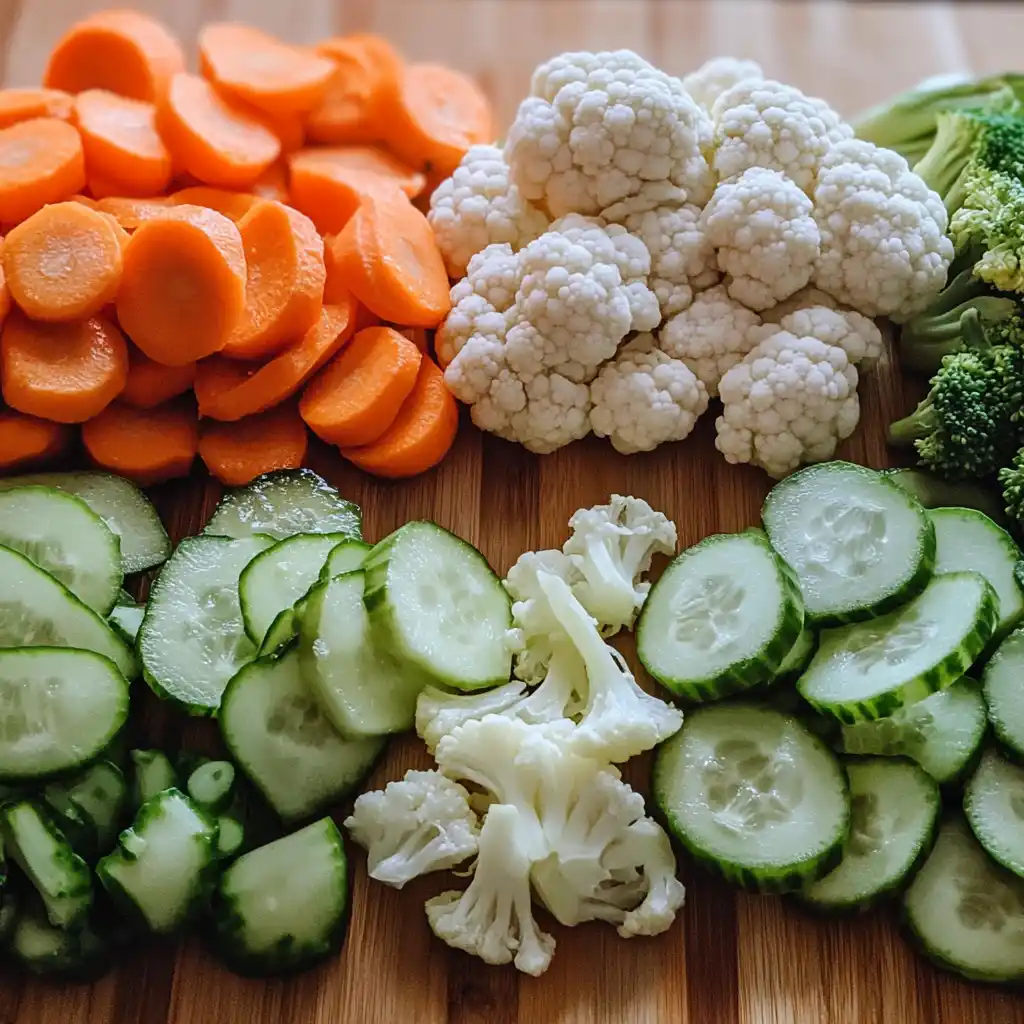
Not sure what’s in season near you? Check out your local farmers’ market or grocer for the freshest picks available.
Looking for something light and tangy? Try this refreshing fresh cucumber salad recipe that shares similar crisp textures and flavors.
The Ideal Ingredients for a Marinated Vegetable Salad
Base Ingredients to Include in Every Recipe
Every flavorful marinated vegetable salad starts with a strong base of vegetables and a well-balanced marinade. While you can customize based on taste and season, these base ingredients are found in most classic versions:
- Cauliflower florets – Adds a crunchy texture and soaks up vinaigrette well.
- Broccoli florets – Another crisp, fibrous vegetable that holds onto flavor.
- Carrot coins or sticks – Slightly sweet, balances the acidity of the dressing.
- Cucumbers – Bring a refreshing, juicy crunch.
- Red onion slices – Adds a bit of sharpness that mellows as it marinates.
- Cherry tomatoes – For bursts of sweetness and vibrant color.
- Celery – Crunchy and hydrating.
- Bell peppers (red, yellow, green) – Sweet and colorful additions that brighten the dish.
You can mix and match depending on your taste or what’s available, but having a balance of crunch (like carrots and celery), absorbent vegetables (like cauliflower and broccoli), and juicy veggies (like tomatoes and cucumbers) creates the best contrast in flavor and texture.
Flavor Boosters: Herbs, Spices, and Add-ins
Want your marinated vegetable salad to go from good to unforgettable? That’s where the flavor boosters come in. Adding fresh herbs, spices, and creative mix-ins can elevate the taste without much extra effort. Here are some standout options:
| Category | Suggestions | Purpose |
|---|---|---|
| Fresh Herbs | Parsley, dill, basil, cilantro | Adds bright, herbal notes |
| Spices | Black pepper, garlic powder, mustard seed, paprika | Enhances depth and warmth |
| Sweeteners | A touch of sugar or honey | Balances the acidity of vinegar |
| Acidic Zing | Apple cider vinegar, red wine vinegar, lemon juice | Core of the marinade for that tangy punch |
| Oil Base | Extra virgin olive oil, avocado oil | Carries flavors and coats the vegetables |
| Optional Add-ins | Feta cheese, olives, chickpeas, roasted nuts | Adds protein, saltiness, or extra crunch |
Don’t forget the power of garlic—freshly minced cloves or garlic powder both work wonders.
Mastering the Marinade for the Perfect Marinated Vegetable Salad
Choosing the Right Oils, Vinegars, and Seasonings
The real magic in a marinated vegetable salad lies in the marinade—that tangy, herbaceous blend that transforms raw vegetables into flavor-packed bites. If your marinade falls flat, so does your salad. But when it’s done right, it elevates every vegetable it touches.
Here’s what you’ll need to build the perfect base for your marinated vegetable salad:
Best Oils to Use:
The oil serves as the rich carrier that helps coat the vegetables and lock in flavor.
- Extra virgin olive oil: The gold standard for any marinated vegetable salad.
- Avocado oil: A lighter, buttery option with heart-healthy fats.
- Neutral oils: Such as grapeseed or canola, if you want the veggies and herbs to shine.
Ideal Vinegars and Acids:
Vinegar gives the salad its signature zing, adding brightness and depth.
- Apple cider vinegar (sweet and tangy)
- Red wine vinegar (bold and fruity)
- White wine vinegar (light and sharp)
- Lemon or lime juice (fresh and zesty)
Seasoning and Flavor Add-ins:
Spices, herbs, and aromatics provide the character of your marinated vegetable salad.
- Fresh garlic or garlic powder for a kick of savory depth
- Dried herbs like oregano, thyme, or Italian seasoning
- Mustard powder or Dijon to emulsify and add bite
- Salt and black pepper to round it all out
- Sugar or honey to mellow the acidity if needed
Pro Tip: Start simple. Use high-quality oil and vinegar in a 2:1 ratio (e.g., ½ cup oil to ¼ cup vinegar), then build with herbs and seasoning.
Quick Marinade Recipe for Marinated Vegetable Salad:
1/2 cup extra virgin olive oil
1/4 cup red wine vinegar
1 teaspoon salt
1/2 teaspoon black pepper
1 teaspoon dried oregano
1 garlic clove, minced
1 teaspoon sugar (optional)
Whisk ingredients until fully combined, or shake in a jar until emulsified.
Creating the Right Flavor Balance
Getting the marinade right is key to making a mouthwatering marinated vegetable salad. It’s all about balancing tangy, sweet, and savory notes so no one flavor overwhelms the others. Here’s how to adjust your mix:
| If It Tastes… | Do This… |
|---|---|
| Too Sharp | Add a teaspoon of honey or sugar |
| Too Flat | Boost the salt, garlic, or mustard |
| Lacking Brightness | Squeeze in fresh lemon or more vinegar |
| Too Oily | Cut the oil slightly and add more acid |
Tip: Always taste your marinade before adding it to the vegetables. It should be bold—remember, the flavor will soften as it infuses into the veggies.
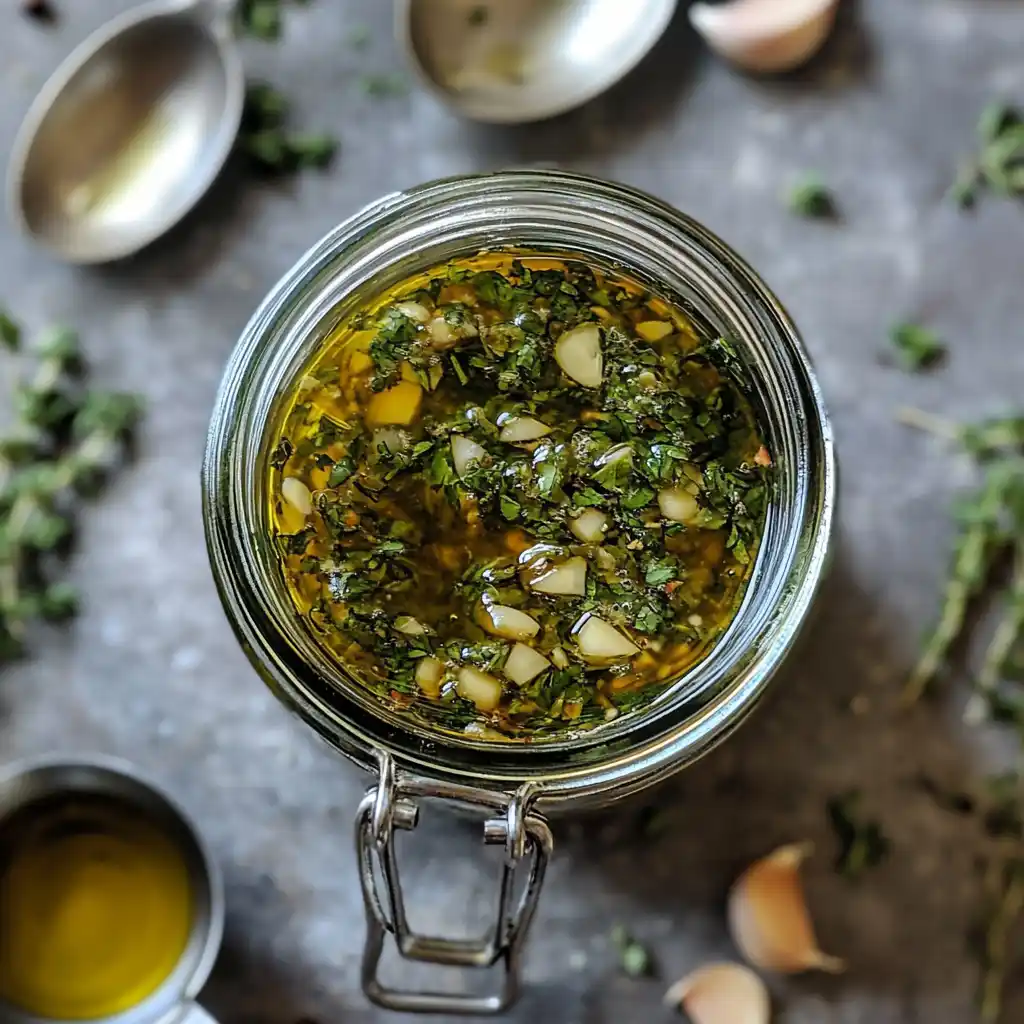
Why This Matters for SEO & Flavor:
A well-balanced marinade ensures your marinated vegetable salad isn’t just colorful—it’s crave-worthy. When every bite is tangy, herbaceous, and deeply infused with flavor, people will come back for seconds—and search engines will recognize your content’s authority too.
Step-by-Step: How to Make Marinated Vegetable Salad at Home
Prepping and Chopping Vegetables Correctly
Making a flavorful marinated vegetable salad starts with choosing and cutting your vegetables properly. Uniform cuts help the marinade coat everything evenly and make each bite more enjoyable.
Step 1: Select and Wash Your Vegetables
Choose fresh, firm vegetables. Popular choices include:
- Cauliflower (broken into small florets)
- Broccoli (bite-sized florets)
- Carrots (thin slices or matchsticks)
- Cucumbers (halved and sliced)
- Red onions (thin slices)
- Bell peppers (julienned)
- Cherry tomatoes (halved)
Wash all vegetables thoroughly to remove dirt and pesticides. Dry them well so the marinade sticks better.
Step 2: Blanch Tougher Vegetables (Optional but Recommended)
If using firm vegetables like cauliflower or carrots, blanching them for 1–2 minutes in boiling water can help soften them slightly. Immediately transfer to an ice bath to stop the cooking and lock in color.
Step 3: Chop Consistently
Cut all vegetables into similar-sized pieces. This ensures they marinate evenly and look more appealing in your salad bowl.
Mixing, Marinating, and Storage Tips
With your veggies ready, it’s time to assemble your marinated vegetable salad.
Step 4: Prepare Your Marinade
Use a base ratio of:
- ½ cup olive oil
- ¼ cup vinegar (apple cider or red wine)
- 1 tsp salt
- ½ tsp pepper
- 1–2 tsp dried herbs (e.g., oregano, basil)
- 1 minced garlic clove
- 1 tsp sugar or honey (optional)
Whisk or shake until emulsified.
Step 5: Combine and Toss
Place the vegetables in a large bowl or food-safe container. Pour the marinade over and toss until everything is coated thoroughly. Make sure the veggies are evenly saturated.
Step 6: Let It Sit
For best results, refrigerate the salad for at least 4–6 hours, preferably overnight. This gives the vegetables time to absorb the marinade fully. Stir once or twice to redistribute flavors.
Step 7: Store Properly
Use an airtight container and store in the fridge. The marinated vegetable salad will keep for up to 5–7 days.
| Storage Tip | Why It Matters |
|---|---|
| Use glass containers | Won’t absorb odors and keeps salad fresh |
| Avoid metal bowls | Can react with vinegar and alter taste |
| Stir before serving | Redistributes marinade and enhances flavor |
Make-Ahead and Storage Tips for Busy Lives
How Long Can Marinated Vegetable Salad Last in the Fridge?
One of the biggest advantages of a marinated vegetable salad is its long shelf life compared to traditional leafy salads. Because the vegetables are firm and the marinade acts as a preservative, this salad keeps exceptionally well in the refrigerator.
Shelf Life:
- Optimal flavor: 24–72 hours after marinating
- Safe to eat: Up to 7 days when stored properly
After day one, the flavors really shine. In fact, many people say the salad tastes even better after sitting overnight. Just give it a good stir before serving to redistribute the marinade.
| Time in Fridge | Flavor Quality | Safety |
|---|---|---|
| 0–1 days | Light flavor, crisp | Excellent |
| 2–3 days | Deep, rich flavor | Excellent |
| 4–5 days | Peak marinated taste | Great |
| 6–7 days | Mild texture change | Still safe |
| 8+ days | Soft/mushy, discard | Not recommended |
Best Containers for Storing and Serving
Proper storage ensures your marinated vegetable salad stays crisp and safe to eat. Here are the best practices:
1. Use Airtight Glass Containers:
Glass is non-reactive, meaning it won’t interact with vinegar or leach flavors into the marinade. It also preserves freshness better than plastic.
2. Avoid Metal Bowls:
Metals like aluminum or copper can react with the vinegar, giving your salad an off flavor. Stick to stainless steel only if necessary—and avoid long-term storage in it.
3. Store in the Fridge at the Right Spot:
Place your container in the coldest part of the fridge (usually near the back) to maintain freshness.
4. Toss Before Serving:
Vegetables at the bottom may soak up more flavor than those on top. Stir or shake the salad well before serving.
| Container Type | Pros | Cons |
|---|---|---|
| Glass with Lid | Keeps salad fresh, non-reactive | Heavier, breakable |
| Plastic (BPA-free) | Lightweight, easy to store | May absorb odors over time |
| Mason Jars | Great for portioning & marinating | Limited capacity per jar |
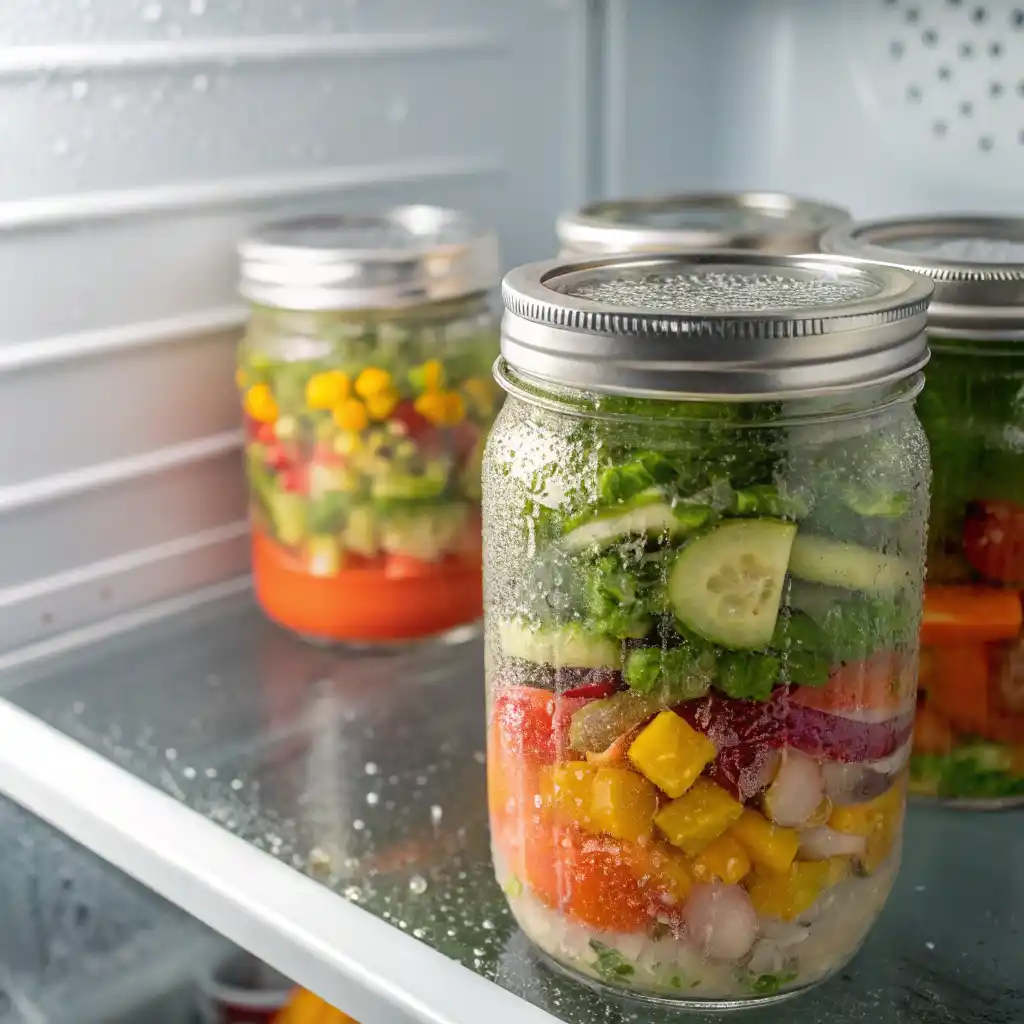
Regional Twists and Global Takes on Marinated Vegetable Salad
Southern-Style Marinated Salads
In the American South, marinated vegetable salad often takes on a sweeter, bolder profile. It’s not uncommon to find recipes loaded with sugar, apple cider vinegar, and even canned vegetables. This version focuses on sweet-and-sour balance and old-fashioned flavor.
Key Characteristics of Southern-Style Marinated Vegetable Salad:
- Vegetables used: Canned green beans, peas, celery, corn, red onion
- Dressing: Apple cider vinegar, vegetable oil, sugar, dry mustard, salt, and pepper
- Texture: Soft, tender veggies with a syrupy marinade
- Flavor: Sweet upfront, tangy finish
This salad is typically made in large batches and served chilled at potlucks, picnics, or church gatherings. It’s simple, satisfying, and keeps for days—perfect for Southern hospitality.
Greek-Inspired and Mediterranean Versions
Across the Atlantic, marinated vegetable salad takes on a Mediterranean character, emphasizing olive oil, lemon, herbs, and bold additions like feta and olives. The flavors are clean, herbaceous, and fresh—ideal for summer meals.
Mediterranean Marinated Vegetable Salad Essentials:
- Vegetables used: Cherry tomatoes, cucumbers, bell peppers, red onions, artichoke hearts
- Add-ins: Kalamata olives, crumbled feta cheese
- Dressing: Extra virgin olive oil, red wine vinegar or lemon juice, garlic, oregano, parsley
- Flavor: Savory, tangy, herb-driven
Often served as a side with grilled meats, seafood, or hummus platters, this style of marinated vegetable salad brings the sunny Mediterranean coast to your plate. It’s also naturally vegetarian, making it an inclusive option for diverse diets.
Bonus: Asian Fusion and Global Variants
You don’t have to stop with Mediterranean or Southern styles. Here are a few creative takes:
- Asian Fusion: Use rice vinegar, sesame oil, soy sauce, and napa cabbage or snap peas
- Mexican Twist: Add corn, black beans, jalapeño, lime juice, and cilantro
- Middle Eastern Style: Toss in chickpeas, cumin, lemon, and mint
Each version keeps the spirit of a marinated vegetable salad while reflecting its own culinary roots.
Serving Suggestions and Pairing Ideas
Best Dishes to Pair With a Marinated Vegetable Salad
Because it’s tangy, crunchy, and packed with flavor, marinated vegetable salad makes the perfect sidekick to countless main courses. Whether you’re planning a picnic, dinner party, or meal prep for the week, this salad delivers big on taste and flexibility.
Perfect Pairings for Any Meal:
- Grilled Proteins: Chicken, steak, shrimp, tofu, or even portobello mushrooms
- Roasted Dishes: Pork tenderloin, baked fish, or a whole roasted chicken
- BBQ Favorites: Ribs, pulled pork, burgers, hot dogs—its acidity cuts through rich flavors
- Comfort Classics: Lasagna, casseroles, mac & cheese (yes, it adds a refreshing contrast)
- Brunch Boards: Serve next to deviled eggs, quiche, cold cuts, and crusty bread
Pro Tip: Add a dollop of hummus, tzatziki, or herbed ricotta on the side for a creamy contrast to the zesty crunch of the salad.
How to Serve It for BBQs, Picnics, and Holidays
One of the biggest perks of a marinated vegetable salad is that it’s made ahead—and actually gets better with time. That makes it an ideal addition to any event where flavor, convenience, and visual appeal matter.
Event-Based Serving Tips:
| Occasion | Serving Suggestions |
|---|---|
| BBQ or Cookout | Chill in a cooler and serve with grilled mains |
| Picnic | Pack in jars or airtight containers—no dressing needed on site |
| Holiday Feast | Serve in a large glass bowl to show off colorful layers |
| Potluck Party | Garnish with fresh herbs or crumbled cheese just before serving |
Hosting Tip: Serve with toothpicks or mini forks in individual cups for easy, mess-free mingling at parties.
Bonus Tip: Want a vegan or keto-friendly menu? This salad fits both! Just skip sugar in the marinade and avoid cheese-based toppings.
Don’t miss our three bean salad recipe—another marinated favorite that’s protein-rich and perfect for picnics.
Frequently Asked Questions About Marinated Vegetable Salad
What vegetables are good to marinate?
Great question—and the beauty of a marinated vegetable salad is its versatility. Some vegetables soak up marinade better than others, delivering bold flavor and maintaining a crisp bite. The best ones include:
Cauliflower and broccoli: Absorb marinade deeply and stay crunchy
Carrots: Add sweetness and crunch
Bell peppers: Bright, sweet, and vibrant
Cucumbers: Refreshing and soak up vinaigrette fast
Red onions: Lose their bite and gain mellow flavor
Cherry tomatoes: Offer juicy bursts of tang and sweetness
Celery and radishes: Add crunch and a slight peppery zing
Feel free to mix and match—just avoid overly soft veggies like avocado or eggplant, which can turn mushy after soaking.
What are the ingredients in marinated vegetable salad?
A classic marinated vegetable salad includes a mix of crisp vegetables and a vinaigrette-style marinade. Common ingredients are:
Vegetables: Cauliflower, broccoli, carrots, cucumbers, tomatoes, onions, peppers
Marinade: Olive oil, vinegar (apple cider or red wine), garlic, salt, pepper, herbs (oregano, basil), and a touch of sugar or honey
Optional Add-ins: Olives, feta cheese, chickpeas, fresh herbs like parsley or dill
Each ingredient brings a layer of flavor or texture to the dish, and the marinade binds everything together with zesty perfection.
How long does marinated vegetable salad last in the fridge?
One of the key benefits of a marinated vegetable salad is its long fridge life. When stored in an airtight container:
Best flavor: After 24–48 hours of marination
Safe to eat: Up to 7 days if kept cold (below 40°F / 4°C)
Tip: Stir every day or two to redistribute the marinade and maintain texture
Just be sure to use firm vegetables, and avoid leafy greens—they won’t hold up as well.
How long do marinated vegetables last?
Marinated vegetables in general—whether part of a salad or stored individually—can last:
Up to 1 week in the refrigerator (if using fresh vegetables and vinegar-based marinade)
Longer if pickled properly, though that enters the realm of canning and fermentation
The vinegar and salt in the marinade naturally help preserve the vegetables, but always check for off smells or texture changes after day 5 or 6.
Pro Tip: Use glass jars for storing marinated vegetables—odor-free, non-reactive, and they keep flavors intact.
Final Thoughts: Make Marinated Vegetable Salad Your Weekly Staple
Fresh, crisp, tangy, and endlessly versatile—marinated vegetable salad isn’t just a side dish; it’s a fridge staple. Whether you prep it for busy weeknights, bring it to a picnic, or serve it at your next dinner party, it delivers bold flavor and bright color every time. With the right vegetables, a simple marinade, and just a little time, you’ll always have something delicious on hand that’s as good on day five as it is on day one.
Print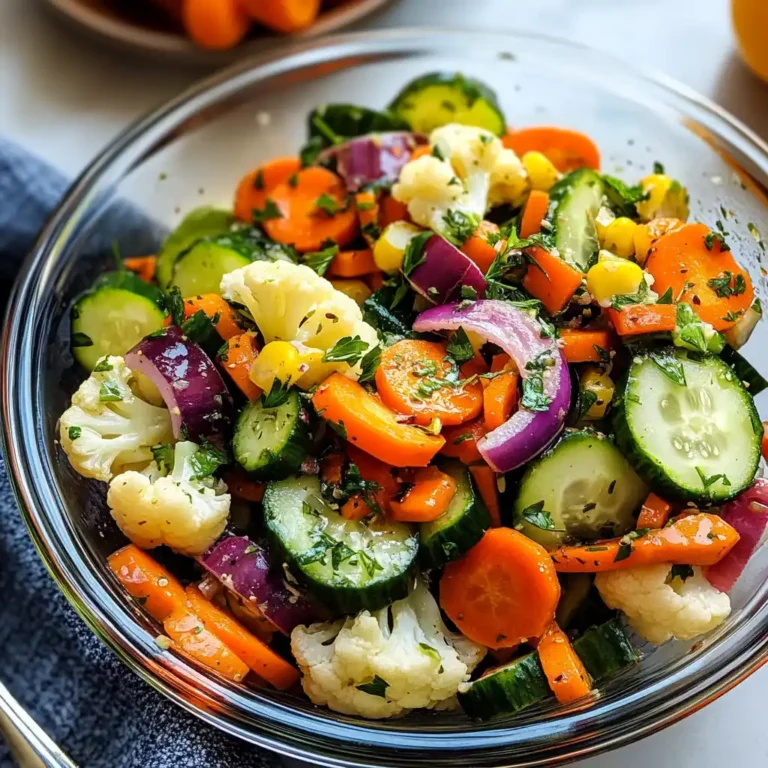
Marinated Vegetable Salad – The Ultimate Guide to a Flavorful, Healthy Side Dish
A crisp, colorful, and tangy salad featuring fresh vegetables soaked in a vibrant vinaigrette—perfect for meal prep, BBQs, and healthy eating.
- Total Time: 22 minutes
- Yield: 6 servings 1x
Ingredients
-
2 cups cauliflower florets
-
2 cups broccoli florets
-
1 cup carrot slices
-
1 cup cucumber slices
-
1 cup cherry tomatoes, halved
-
½ red onion, thinly sliced
-
1 cup bell peppers (red, yellow, or green), sliced
-
½ cup celery, chopped
-
½ cup olive oil
-
¼ cup red wine vinegar
-
1 tsp salt
-
½ tsp black pepper
-
1 tsp dried oregano
-
1 garlic clove, minced
-
1 tsp sugar (optional)
Instructions
-
Wash and chop all vegetables into bite-sized pieces.
-
Blanch tougher vegetables like cauliflower and carrots for 1–2 minutes, then cool in an ice bath.
-
In a bowl or jar, combine olive oil, vinegar, salt, pepper, oregano, garlic, and sugar. Whisk or shake to combine.
-
Toss the vegetables with the marinade in a large bowl until evenly coated.
-
Cover and refrigerate for at least 4–6 hours or overnight.
-
Stir before serving to redistribute the marinade.
Notes
This salad keeps well in the fridge for up to 7 days. Use airtight glass containers for best freshness and flavor.
- Prep Time: 20 minutes
- Cook Time: 2 minutes (blanching optional)
- Category: Salad
- Method: Marinated
- Cuisine: American
Nutrition
- Serving Size: 1 cup
- Calories: 120
- Sugar: 3g
- Sodium: 180mg
- Fat: 10g
- Saturated Fat: 1.5g
- Unsaturated Fat: 8g
- Trans Fat: 0g
- Carbohydrates: 7g
- Fiber: 2g
- Protein: 2g
- Cholesterol: 0mg
Keywords: marinated salad, vegetable salad, vinaigrette salad, meal prep, healthy salad

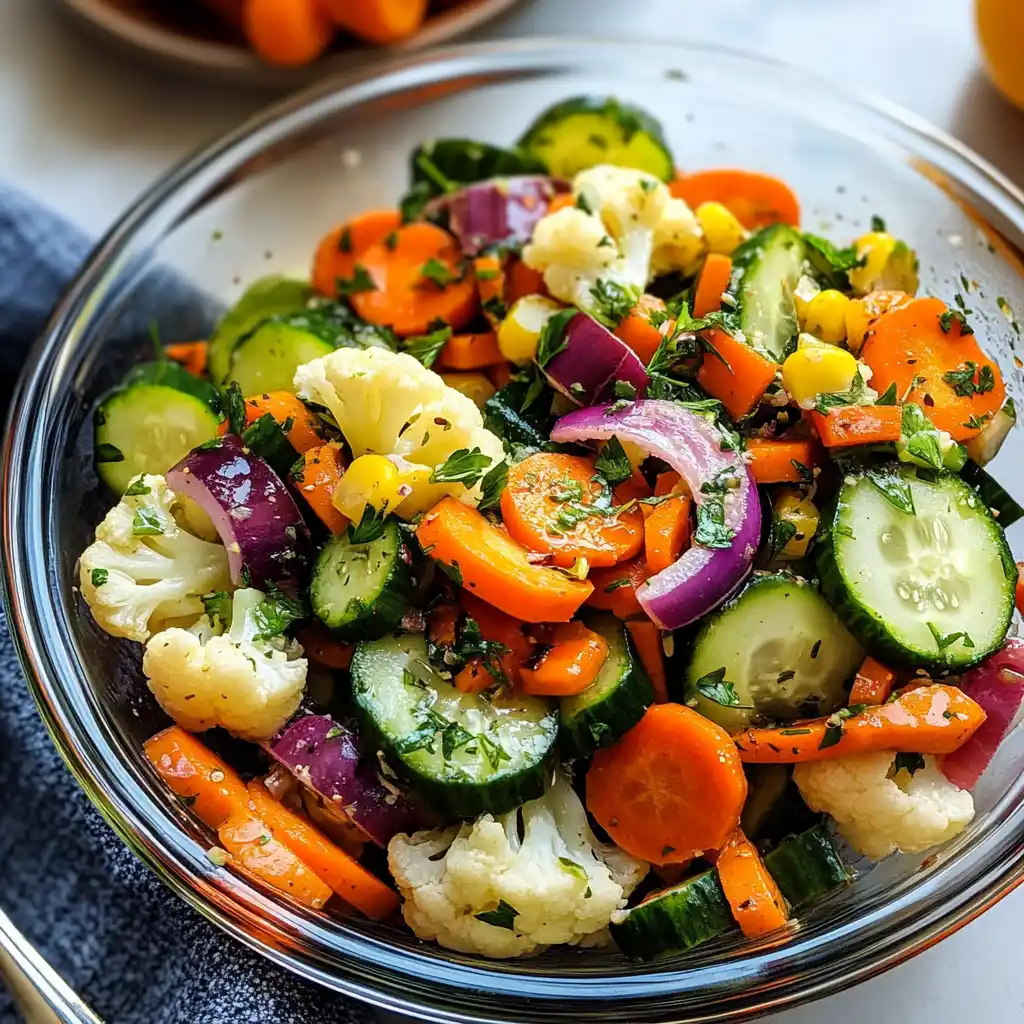
1 thought on “Marinated Vegetable Salad – The Ultimate Guide to a Flavorful, Healthy Side Dish”